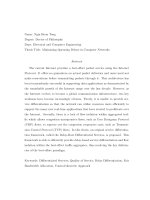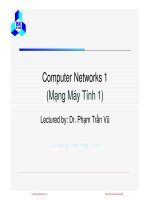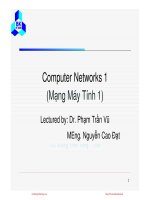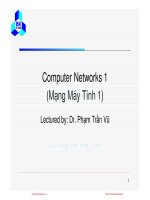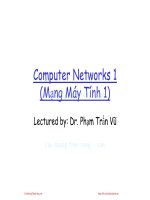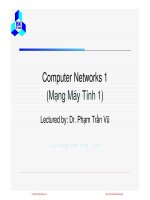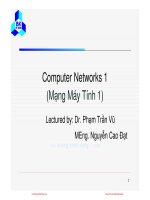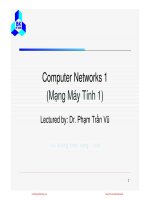Lecture Computer networks 1: Lecture 8 - Phạm Trần Vũ
Bạn đang xem bản rút gọn của tài liệu. Xem và tải ngay bản đầy đủ của tài liệu tại đây (1.75 MB, 33 trang )
Computer Networks 1
(Mạng Máy Tính 1)
Lectured by: Dr. Phạm Trần Vũ
1
CuuDuongThanCong.com
/>
Lecture 8: Transport Layer and
Socket Programming with Java
Reference:
Chapter 6 - “Computer Networks”,
Andrew S. Tanenbaum, 4th Edition, Prentice Hall, 2003.
2
CuuDuongThanCong.com
/>
The Transport Service
•
Services Provided to the Upper Layers
•
Transport Service Primitives
•
Berkeley Sockets
•
An Example of Socket Programming:
An Internet File Server
3
CuuDuongThanCong.com
/>
Services Provided to the Upper
Layers
The network, transport, and application layers.
4
CuuDuongThanCong.com
/>
Transport Service Primitives
The primitives for a simple transport service.
5
CuuDuongThanCong.com
/>
Transport Service Primitives (2)
The nesting of TPDUs, packets, and frames.
6
CuuDuongThanCong.com
/>
Transport Service Primitives (3)
A state diagram for a simple connection management scheme.
Transitions labeled in italics are caused by packet arrivals. The
solid lines show the client's state sequence. The dashed lines show
7
the server's state sequence.
CuuDuongThanCong.com
/>
Berkeley Sockets
The socket primitives for TCP.
8
CuuDuongThanCong.com
/>
Elements of Transport Protocols
•
Addressing
•
Connection Establishment
•
Connection Release
•
Flow Control and Buffering
•
Multiplexing
•
Crash Recovery
9
CuuDuongThanCong.com
/>
Addressing
•
Application addresses on a host: Ports
TSAPs, NSAPs and transport connections.
10
CuuDuongThanCong.com
/>
Connection Establishment
Three protocol scenarios for establishing a connection using a
three-way handshake. CR denotes CONNECTION REQUEST.
(a) Normal operation,
(b) Old CONNECTION REQUEST appearing out of nowhere.
(c) Duplicate CONNECTION REQUEST and duplicate ACK.
11
CuuDuongThanCong.com
/>
Connection Release
Abrupt disconnection with loss of data.
CuuDuongThanCong.com
/>
12
Connection Release (2)
The two-army problem.
13
CuuDuongThanCong.com
/>
Connection Release (3)
Four protocol scenarios for releasing a connection. (a) Normal
case of a three-way handshake. (b) final ACK lost.
14
CuuDuongThanCong.com
/>
The Internet Transport Protocols
UDP – User Datagram Protocol
•
Connection-less service
•
Useful in client-server situations: Remote
Procedure Call, real-time AV streaming
TCP – Transmission Control Protocol
•
Connection oriented service
•
Reliable byte stream services over unreliable
network
•
Most widely used in Internet
15
CuuDuongThanCong.com
/>
UDP Header
16
CuuDuongThanCong.com
/>
TCP Service Model
Sender and receiver need to create
connection end-points first, called sockets
Each socket is addressed by the host IP
address and a port number
Port numbers < 1024 are reserved
TCP connections are full-duplex
17
CuuDuongThanCong.com
/>
Typical TCP Applications and Ports
Port
21
23
25
69
79
80
110
119
Protocol
FTP
Telnet
SMTP
TFTP
Finger
HTTP
POP-3
NNTP
Use
File transfer
Remote login
Trivial File Transfer Protocol
Lookup info about a user
World Wide Web
Remote e-mail access
USENET news
18
CuuDuongThanCong.com
/>
The TCP Segment Header
19
CuuDuongThanCong.com
/>
TCP Connection Establishment
(a) TCP connection establishment in the normal case.
(b) Call collision.
20
CuuDuongThanCong.com
/>
Socket Programming in Java
21
CuuDuongThanCong.com
/>
Client-Server Application with UDP (1)
Client operations
Identify server IP and port
Create UDP socket
Send/receive data to server
Close socket
Server operations
Create socket and register with the system
Read client messages and respond to client
22
CuuDuongThanCong.com
/>
Client-Server Application with UDP (2)
23
CuuDuongThanCong.com
/>
Client-Server Application with TCP (1)
Client operations
Identify server IP and port
Create UDP socket
Setup connection to server
Send/receive data
Close connection
24
CuuDuongThanCong.com
/>
Client-Server Application with TCP (2)
Server operations
Create and register socket
Listen and wait for incoming connections
Accept connection
Send/receive data
Close connection
25
CuuDuongThanCong.com
/>
